Peter Garland
Plain Songs: “Love Comes Quietly” (after Robert Creeley)
CB0070
Release date: June 6, 2025

Plain Songs: “Love Comes Quietly” (after Robert Creeley) is a haunting piece for pipe organ, performed by organ virtuoso Carson Cooman on the C.B. Fisk Opus 139 organ, Harvard Memorial Church.
Garland writes about the music:
“I wanted to write a piece for organ that would be intimate and mostly quiet, emphasizing the nature of the organ as a wind instrument capable of long, sustained tones. I wanted the musical textures to be open and transparent, rather than dense and massive. I also had in mind smaller historical organs and their music.
“The reference to the poet Robert Creeley is relevant to the above-mentioned goals. I greatly admire the simplicity and clarity of his poetic language; its lucidity and how it rarely strays from the directness of popular, vernacular speech. I wanted to emulate those qualities in my music to the extent it was possible: to transfer the music of his poetry into the language of my music.”
Peter Garland is a composer, world traveler, musicologist, writer, and former publisher (Soundings Press) whose music is informed by his well-traveled ear and strong sense of personal vision. He studied with Harold Budd and James Tenney and maintained long friendships with Lou Harrison, Conlon Nancarrow, Paul Bowles, and Dane Rudhyar. As a musicologist, he has focused on Native American, Mexican, and Southwestern American musics and 20th-century experimental composers of the Americas, championing the work of Revueltas, Partch, and Nancarrow long before their music became fashionable and regularly programmed.
Since the early 1970s, Garland’s music has been marked by a return to a “radical consonance” and simplification of formal structure influenced by Cage, Harrison, early minimalism, and a great variety of world musics. His unique and highly engaging pieces have been played around the world by such noted performers as William Winant; pianists Aki Takahashi, Herbert Henck, and Sarah Cahill; accordionist Guy Klucevsek; and the Kronos Quartet and released on the Cold Blue, Tzadik, New Albion, Mode, Avant, Toshiba-EMI/Angel, New World, and other labels. Garland’s music has appeared on eight previous Cold Blue CDs, which include The Basketweave Elegies, Moon Viewing Music (Inscrutable Stillness Studies #1), Three Dawns & Bush Radio Calling, After the Wars, and String Quartets, as well as on four of the label’s anthologies.
“Garland’s music seems to be about the sheer expressive power of sound itself. . . . I feel he is one of our true originals.” —Robert Carl, Fanfare magazine
“Ever his own man, Garland has moved beyond a strictly minimalist phase of evolving melodic and rhythmic patterns into a hybrid sphere of many influences from the panorama of world music, suggestive of such composers as Conlon Nancarrow and Lou Harrison.” —San Francisco Chronicle
“[Garland] is an avatar of an experimental American tradition . . . a composer of mesmerizing music; and in many ways, the musical conscience of my generation.”—Kyle Gann, Chamber Music magazine
“‘Radical consonance’ has been used to describe Garland’s music…an apt choice of words.” —Raymond Tuttle, Fanfare
Carson Cooman is an active composer and performer. As an acclaimed concert organist he specializes in the performance of contemporary music—and more than 300 compositions by over 100 composers have been written for him by such composers as Kyle Gann, Jennifer Higdon, Jo Kondo, Robert Moran, Howard Skempton, and Linda Catlin Smith. His organ performances can be heard on a number of CDs and more than 6,000 recordings available online. As a composer, Cooman has written hundreds of works—from solo instrumental pieces to operas to orchestral works to hymn tunes—which have been performed on all six inhabited continents, in venues that range from Carnegie Hall to the basket of a hot air balloon, and have appeared on over forty recordings. Cooman is also a writer on musical subjects, producing articles and reviews for a number of publications. He is currently Research Associate in Music and Composer in Residence at Harvard’s Memorial Church.
“Carson Cooman is one of the most versatile and active musicians of our time. Pianist, organist, composer, and improviser, he is excellent in every field.” —Music and Vision
“Cooman’s success as a composer for the organ is due in large part to his innate understanding of the instrument as a performer.” —American Record Guide
“Carson Cooman is a nimble, nuanced, and eloquent advocate.” —Choir & Organ
John Luther Adams
Waves and Particles
CB0069
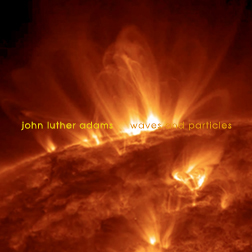
Waves and Particles is a shimmery, beautiful, and virtuosic string quartet. In six movements—particle dust, spectral waves, velocity waves, triadic waves, murmurs in a chromatic field, and particles rising—it is alternately full and vigorous and quiet and spare. Performed by the incredible, illustrious JACK Quartet.
JACK’s performance of Waves and Particles is nominated for a 2025 Grammy in the Best Chamber Music/Small Ensemble Performance category.
This is Cold Blue Music’s third album of John Luther Adams’s string quartets performed by the JACK Quartet. Waves and Particles was co-commissioned by Black Mountain College Museum + Arts Center, Summer Stages Dance at The Institute of Contemporary Art/Boston, and Liz Gerring Dance Company. Premiered by JACK Quartet at Black Mountain College, November 2021.
John Luther Adams is a Pulitzer- and Grammy-winning composer who lived for many years in Alaska, where his work derived much of its unique character from the landscape and weather of the Great North. Some years ago, he moved from Alaska, living in various desert and mountain areas in South and Central America—places that also inspired and found expression in his music. He currently resides in rural New Mexico. He is a long-time associate of the Cold Blue label; his music has appeared on nine previous Cold Blue CDs, including Darkness and Scattered Light, Houses of the Wind, Arctic Dreams, Everything That Rises, and the Grammy-nominated Lines Made by Walking.
“John Luther Adams . . . one of the most original musical thinkers of the new century.” — Alex Ross, The New Yorker
“His music becomes more than a metaphor for natural forces: it is an elemental experience in its own right.” —Tom Service, The Guardian
“His music perfectly echoes the landscape he loves: impersonal, relentless, larger than human scale, yet gorgeous, a quiet chaos of colors, suffused with light.” —Kyle Gann, Chamber Music Magazine
“Adams’s music sounds like it has nothing to accomplish. It simply exists, hanging in mid-air, waiting to be listened to.” —All-Music Guide
“Adams’s music is as hypnotic as it is different.” —MusicWeb Int’l
“Adams’s powerful music finds inspiration, depth of field, and sonic substance in the shapes and textures of the natural world and, most of all, in the composer’s own deep and passionate commitment to the act of listening itself.” —Dusted magazine
“Adams’ manner is that of Thoreau—to be in a place, incorporate it into his memory and values, and recreate that through music. It misses the point to say he is inspired by nature—Adams is changed by nature and his music is a catalogue of the places that changed him. . . . Adams [is] an important and necessary musician for our time.” —New York Classical Review
“Adams’s major works have the appearance of being beyond style; they transcend the squabbles of contemporary classical music.” —Alex Ross, The New Yorker
JACK Quartet has been deemed “superheroes of the new music world” (Boston Globe), “the go-to quartet for contemporary music, tying impeccable musicianship to intellectual ferocity and a take-no-prisoners sense of commitment” (The Washington Post), and “a musical vehicle of choice to the next great composers who walk among us” (Toronto Star). The group is focused on the commissioning and performance of new works, leading it to work closely with composers John Luther Adams, Derek Bermel, Chaya Czernowin, James Dillon, Brian Ferneyhough, Beat Furrer, Georg Friedrich Haas, Vijay Iyer, György Kurtág, Helmut Lachenmann, George Lewis, Steve Mackey, Matthias Pintscher, Steve Reich, Roger Reynolds, Wolfgang Rihm, Salvatore Sciarrino, Julia Wolfe, John Zorn, and many others. JACK has recorded three earlier albums of Adams’s music for Cold Blue: Lines Made by Walking (CB0058), Everything That Rises(CB0051), and The Wind in High Places(CB0041).
“The string quartet may be a 250-year-old contraption, but young, brilliant groups like the JACK Quartet are keeping it thrillingly vital.”—The Washington Post
Christopher Cerrone
Beaufort Scales
CB0068
on Spotify’s “Classical: Best of 2024” list
on Textura‘s 2024 “Top 20 Classical (Vocal)” list
#1 on “John Schaefer’s Highly Opinionated Top Ten of 2024” (New Sounds, WNYC)
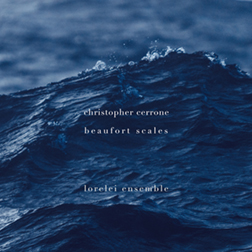
Beaufort Scales is Cerrone’s lush, alluring music for women’s voices and electronics, commissioned and performed by the Lorelei Ensemble. Its text is drawn from the Beaufort Wind Force Scale (a measure of wind speed, originally as it related to observed sea conditions) created by Francis Beaufort in 1805, as well as writings by Herman Melville, F. Scott Fitzgerald, and Anne Carson.
Lorelei’s performance of Beaufort Scales is nominated for a 2025 Grammy in the Best Chamber Music/Small Ensemble Performance category.
“Beaufort Scales, an otherworldly piece for women’s voices and electronics.” —Steve Smith, Night After Night
“A stunning celebration for vocals and electronics of the winds swirling across the seas…. Exceptionally involving, enwrapping, immersive.” —Rebecca Tavener, Choir & Organ
Christopher Cerrone is a composer whose many compelling works are characterized by a subtle handling of timbre and resonance, a literary bent, and an affinity for multimedia collaborations. He has been a Pulitzer-finalist (2014, for his opera Invisible Cities) and Grammy-nominee. His recent projects include an opera jointly produced by LA Opera and Pittsburgh Opera; an orchestral work with electronics for the Los Angeles Philharmonic; a piano concerto for Shai Wosner; a brass concerto for the Cincinnati Symphony; a violin concerto for Jennifer Koh and the Detroit Symphony; a percussion quartet concerto co-commissioned by Third Coast Percussion, the Chicago Civic Orchestra of the Chicago Symphony, and the Britt Festival; and a work for the Louisville Symphony and baritone Dashon Burton.
“Cerrone is among that select group of young composers whose work is known beyond arcane musical circles.”— David Mermelstein, Wall Street Journal
“One of our most versatile composers under 40.”—Tom Huizenga, NPR
“A gifted composer with an impressive individual voice.” —Chicago Classical Review
The Lorelei Ensemble has been praised for its “full-bodied and radiant sound” (The New York Times) and “stunning precision of harmony, intonation, and . . . spectacular virtuosity” (Gramophone), as well as its programs that champion the extraordinary flexibility and virtuosity of the human voice. Lorelei has recorded the music of living composers Kati Agócs, Peter Gilbert, James Kallembach, David Lang, Jessica Meyer, and Scott Ordway, as well as historical works from William Billings, Guillaume Du Fay, Alfred Schnittke, Tōru Takemitsu, the Turin Codex, and the Codex Calixtinus.
John Luther Adams
Darkness and Scattered Light
CB0067
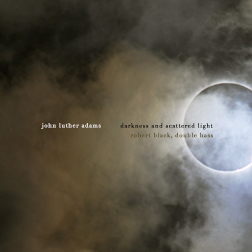
Darkness and Scattered Light is an album of three works—two solos and the title work for five basses—written for and performed by double bassist extraordinaire Robert Black. Beautiful, mesmerizing, virtuosic music.
Robert Black has been nominated for a 2024 Grammy Award (Best Classical Instrumental Solo) for his playing on this album.
And this album was on Alex Ross’s The New Yorker list of “Notable Classical Recordings of 2023.”
John Luther Adams is a Pulitzer- and Grammy-winning composer who lived for many years in Alaska, where his work derived much of its unique character from the landscape and weather of the Great North. About a half-dozen years ago, he moved from Alaska, living in various desert and mountain areas in South and Central America—places that also inspired and found expression in his music. He currently resides in rural New Mexico. He is a long-time associate of the Cold Blue label; his music has appeared on eight previous Cold Blue CDs, including Arctic Dreams, Everything That Rises, and the Grammy-nominated Lines Made by Walking.
“This is one of the most beautiful albums I have heard in years. And so emotional. It seems strange that an album about the vastness of nature should be so human, and so emotionally resonant. As the music goes deeper into exploring the stark, mysterious slowness of the natural world it becomes clear just how little this world cares about what we think about it. Nature doesn’t need us – the majesty of this music reflects our smallness back to us. It is a humbling, devastating kind of beauty.
“It would be hard to imagine a better match of composer and performer than John Luther Adams and Robert Black. Collaborators for decades, they have both dedicated their professional lives to pushing their fields forward, at the highest possible levels. Robert Black is, himself, a national monument, and his playing here is rich and pure and plainspoken. He presents the music to us, unornamented and honest, and painfully direct. And therein lies its beauty, and its power.”—David Lang
“Spectacular bassist Robert Black pairs up with John Luther Adams, one of the most important composers of our time. Black’s visionary commissioning and his realization of and advocacy for the music of our time is unmatched.” —Julia Wolfe
“John Luther Adams . . . one of the most original musical thinkers of the new century.” — Alex Ross, The New Yorker
“His music becomes more than a metaphor for natural forces: it is an elemental experience in its own right.” —Tom Service, The Guardian
“His music perfectly echoes the landscape he loves: impersonal, relentless, larger than human scale, yet gorgeous, a quiet chaos of colors, suffused with light.” —Kyle Gann, Chamber Music Magazine
“Adams’s music sounds like it has nothing to accomplish. It simply exists, hanging in mid-air, waiting to be listened to.” —All-Music Guide
“Adams’s music is as hypnotic as it is different.” —MusicWeb Int’l
“Adams’s powerful music finds inspiration, depth of field, and sonic substance in the shapes and textures of the natural world and, most of all, in the composer’s own deep and passionate commitment to the act of listening itself.” —Dusted magazine
“Adams’ manner is that of Thoreau—to be in a place, incorporate it into his memory and values, and recreate that through music. It misses the point to say he is inspired by nature—Adams is changed by nature and his music is a catalogue of the places that changed him. . . . Adams [is] an important and necessary musician for our time.” —New York Classical Review
“Adams’s major works have the appearance of being beyond style; they transcend the squabbles of contemporary classical music.” —Alex Ross, The New Yorker
Regarding the performer, Robert Black:
“No one on the planet can make the double bass sing, dance, sound like a drum, spin like a top, like Robert Black. Robert has single-handedly reinvented the technique and repertoire of the Double Bass, bringing it bursting into the 21st century.” —Michael Gordon
“I very much appreciate Robert Black for his amazing double bass technique and his real sensitivity and musicianship. I like him a lot, there are only a few such musicians.” — Iannis Xenakis
“Black uncovers unexplored virtuosity on the double bass and performs . . . with eloquence.” —Bass World: The Journal of the International Society of Bassists
“[Black] is an acclaimed practitioner of the double bass . . . one of the growing number of virtuosic double bassists who is passionate about expanding the repertoire and the public profile of the great, but underrated instrument.” —Josef Woodard, Santa Barbara News-Press
“Robert Black’s . . . playing is rhythmically incisive, energetic, clean, and powerful.” —Bass World: The Journal of the International Society of Bassists
Peter Garland
The Basketweave Elegies
CB0066
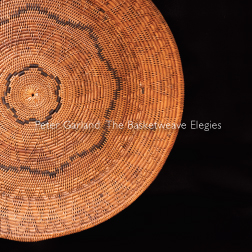
The Basketweave Elegies is an elegant, well-wrought vibraphone solo in nine sections, recorded by renowned new music percussionist William Winant.
Garland writes, “I want to write music that is well-made, sturdy, useful, and beautiful—like a basket; its beauty being the sum result of those first three qualities. . . . I worked on this piece with the same determined focus as if I were weaving a basket. . . . I think one can hear a definite woven quality in the melodic and contrapuntal relationships. . . . Formally, I got an idea from the medieval poetic-musical form the rondeau. . . . There are four ‘core’ movements . . . which are preceded and followed by ‘refrains.’ Of course this being the 21st century and not the 12th, I do not follow this rondeau form in any literal fashion.”
“This exquisite piece . . . feels elemental, instinctive, and natural, as though it were being broadcast from a radio station on the moon, or maybe from somewhere inside your body.”—Amanda Petrusich, The New Yorker (The Basketweave Elegies appeared on The New Yorker‘s “The Best Music of 2023” list)
Composer Peter Garland is a long-time associate of Cold Blue; his music has appeared on seven of the label’s previous CDs.
“Garland’s music seems to be about the sheer expressive power of sound itself…. I feel he is one of our true originals.” —Robert Carl, Fanfare magazine
“‘Radical consonance’ has been used to describe Garland’s music…an apt choice of words.” —Raymond Tuttle, Fanfare
“[Garland] is an avatar of an experimental American tradition … a composer of mesmerizing music; and in many ways, the musical conscience of my generation.” —Kyle Gann, Chamber Music magazine
“Ever his own man, Garland has moved beyond a strictly minimalist phase of evolving melodic and rhythmic patterns into a hybrid sphere of many influences from the panorama of world music, suggestive of such composers as Conlon Nancarrow and Lou Harrison.”—San Francisco Chronicle
“William Winant has been the avant-elite’s go-to percussionist for more than 35 years.” —SPIN magazine
“Winant is a dazzling virtuoso but also a catalytic presence in adventurous music, a percussive dynamo generating rhythms, colours and textures that blaze life into visionary scores.” —Julian Cowley, The Wire magazine
Michael Byron
Halcyon Days
CB0065
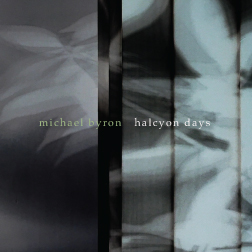
Halcyon Days is a collection of Byron’s vibrant music for mallet percussion ensembles (marimbas, vibraphones, glockenspiels, and chimes) and music for solo and four-hand piano. Includes the pieces Music of Steady Light, Music of Every Night, Drifting Music, Starfields, and Tender, Infinitely Tender. Performers include percussionists William Winant, Michael Jones, Tony Gennaro, and Scott Siler and pianists Lisa Moore, Vicki Ray and Aron Kallay.
Michael Byron’s music, which tends to be harmonically rich, rhythmically detailed, and virtuosic, is often praised for its ability to create uniquely dense constructions out of relatively limited means:
“Byron creates maximalist effect out of minimalist means.” (ClassicalNet)
“One is reminded…of the mobiles of Alexander Calder, which are both fixed and moving. And, like Calder’s work, Byron’s music is immediately comprehensible and beautiful, while it remains experimental.” (San Francisco Bay Guardian)
“Byron’s music, like Ligeti’s, is instantly recognizable, perceptually challenging, beautifully proportioned and deeply satisfying.” (Paris Transatlantic)
“Byron’s music dances with tremulous iridescence.” (Julian Cowley, The Wire)
Nicholas Chase
Tiny Thunder
CB0064
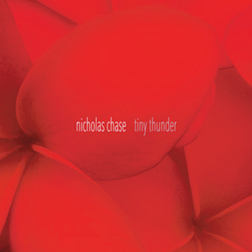
Gorgeous understated music for solo piano, performed by Bryan Pezzone. Includes the pieces Zuòwàng and Tiny Thunder.
Nicholas Chase‘s music has been described as “brawling yet taut” (Los Angeles Times); “crackling, witty” (Albuquerque Journal); “quietly provocative…compelling” (Textura); “brilliant” (The Strad); “powerful…spectacular” (Whittier Press); and “the human brain at its most imaginative” (LA Weekly). He has one previous album on the Cold Blue Music label: Bhajan (CB0046).
John Luther Adams
Houses of the Wind
CB0063

Houses of the Wind is a shimmering, mesmerizing electro-acoustic piece composed in 2021.
The composer writes:
“Much of my music of the past thirty-some-odd years has grown out of my experiences listening to aeolian harps. Yet, until now, I’ve never incorporated those sounds directly into the music
“In the last two decades of the 20th century, I made field recordings of elemental sounds all over Alaska—fire, ice, thunder, glaciers calving into the sea. Recently, I transferred those aging tapes to more stable media. Listening to the very first segment of a small aeolian harp, recorded in the Arctic in the summer of 1989, I was captivated. The voices of the wind singing through the strings of the harp brought back vividly the clarity of light, the sprawling space, and the sense of possibility I had felt.
“Houses of the Wind (2021–22) is composed entirely from that single ten-and-a-half-minute recording, transposed, layered on itself, and sculpted into five new pieces of the same length. The world has changed since then, in ways we couldn’t have imagined. The winds rising around us now seem darker, more turbulent and threatening. Yet still, if this music is haunted by feelings of loss and longing, I hope it also offers some measure of consolation, even peace.”
John Luther Adams is a Pulitzer- and Grammy-winning composer who lived for many years in Alaska, where his work derived much of its unique character from the landscape and weather of the Great North. About a half-dozen years ago, he moved from Alaska, living in various desert and mountain areas in South and Central America—places that also inspired and found expression in his music. He currently resides in rural New Mexico. He is a long-time associate of the Cold Blue label; his music has appeared on eight previous Cold Blue CDs, including Arctic Dreams, Everything That Rises, and the Grammy-nominated Lines Made by Walking.
“One of the most original musical thinkers of the new century.” — Alex Ross, The New Yorker
“His music becomes more than a metaphor for natural forces: it is an elemental experience in its own right.” —Tom Service, The Guardian
“His music perfectly echoes the landscape he loves: impersonal, relentless, larger than human scale, yet gorgeous, a quiet chaos of colors, suffused with light.” —Kyle Gann, Chamber Music Magazine
“Adams’s music sounds like it has nothing to accomplish. It simply exists, hanging in mid-air, waiting to be listened to.” —All-Music Guide
“Adams’s music is as hypnotic as it is different.” —MusicWeb Int’l
“Adams’s powerful music finds inspiration, depth of field, and sonic substance in the shapes and textures of the natural world and, most of all, in the composer’s own deep and passionate commitment to the act of listening itself.” —Dusted magazine
“Adams’ manner is that of Thoreau—to be in a place, incorporate it into his memory and values, and recreate that through music. It misses the point to say he is inspired by nature—Adams is changed by nature and his music is a catalogue of the places that changed him. . . . Adams [is] an important and necessary musician for our time.” —New York Classical Review
“Adams’s major works have the appearance of being beyond style; they transcend the squabbles of contemporary classical music.” —Alex Ross, The New Yorker
Jacob Cooper & Steven Bradshaw
Sunrise
CB0062
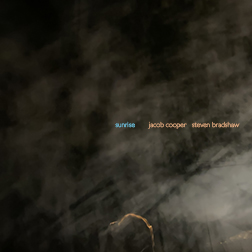
Sunrise is an expansive, incandescent, haunting electro-acoustic work jointly composed and performed by Jacob Cooper and Steven Bradshaw. Created during the 2020–21 pandemic, this alluring, kaleidoscopic piece grows into a tsunami of sound while it casts an eye (ear) back 100 years to derive its text from a popular song composed during the 1918 pandemic: “The World Is Waiting for the Sunrise.”
Cooper and Bradshaw constructed Sunrise via the internet—Bradshaw recording vocal melodies and improvisations that Cooper subjected to electronic manipulation. In this fashion—back and forth, again and again—they spent months composing and realizing the music. (In addition to Cooper and Bradshaw, pianist Dynasty Battles, violinist Clara Kim, and flutist Timothy Munro also contribute performances to the work.)
Jacob Cooper has been lauded as “richly talented” (The New York Times) and a “maverick electronic song composer” (The New Yorker). His music has been commissioned and performed by such ensembles as the Los Angeles Philharmonic New Music Group, Eighth Blackbird, and the Calder Quartet and released by Nonesuch, New Amsterdam, and other record labels. The recording of his string orchestra work Stabat Mater Dolorosa (New Artisans), which the New York Times described as “exhaustingly poignant,” was an NPR Top Ten album in 2020.
A founding member of Variant Six and The Crossing (a Grammy-winning vocal ensemble dedicated to new music), Steven Bradshaw has appeared as a soloist with Bang on a Can, the Philadelphia Chamber Orchestra, and many other groups and recorded and toured with Roomful of Teeth. He premiered Ted Hearne’s Placeat the BAM Next Wave Festival and will reprise his role in it with the LA Philharmonic. He also premiered and gave 300 performances of David Lang’s lifespan. Also a noted visual artist, Bradshaw has exhibited his work at a number of galleries throughout the country.
Chas Smith
Three
CB0061
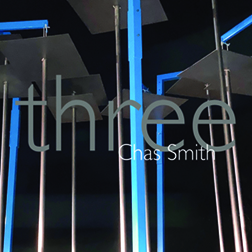
Three new dark and haunting soundscapes from composer-performer-instrument builder Chas Smith, a musician who has created his own unique musical world—complete with its own instruments and “language”—a world of expansive musical tapestries and carefully sculpted textures that evolve via a slow, constant change of aural perspective. This is music that seamlessly blends Smith’s metal sound sculptures and his homemade and hot-rodded steel guitars, all of which are performed by the composer.
“Smith’s pieces are music of experiment and discovery: a way of enabling the physical world to ‘speak’ by investigating, harnessing and organizing its sonic properties. The extraordinary sound-world of Smith’s articulately structured music captivates from the start.”—International Record Review
“Chas Smith, musician, composer, engineer, metal craftsman and inventor, is a classic American original.”—New Times (Los Angeles)
“With Smith’s music, the sounds are as compelling as his concepts and instruments.” —The Wire magazine
“Smith creates unsettling music that is both beautiful and eerie.”—Electronic Musician magazine
John Luther Adams
Arctic Dreams
CB0060

Arctic Dreams is a stunning, gloriously beautiful piece for four string players and four singers, with multiple layers of digital delays that create 32-part canonic textures.
The composer writes:
“This was the first music I composed in my ‘aeolian’ sound world, which grew out of my experiences listening to wind harps on the tundra. As in several of my later string quartets, all the sounds are produced by natural harmonics and open strings. . . . Extensive retuning of the strings is employed.
“The sung text is a series of ‘Arctic Litanies,’ composed of the names of Arctic places, plants, birds, weather, and the seasons, in the languages of the Iñupiat (Alaska Inuit) and Gwich’in (Athabascan) peoples of Alaska.
“Arctic Dreams is dedicated to the memory of my dear friend Barry Lopez, and is titled after one of his greatest books.” [See Adams’s remembrance of Lopez from Harper’s magazine.]
Performed by the incredible Synergy Vocals, a critically acclaimed vocal ensemble that has during the past 25 years recorded music by Steve Reich, Louis Andriessen, David Lang, Luciano Berio, James MacMillian, Steven Mackey, John Adams, Arvo Pärt, and many other composers and performed with the Boston, Chicago, St. Louis, and San Francisco Symphonies, the Los Angeles and New York Philharmonics, as well as other major orchestras and many chamber ensembles. Their performances and recordings have been deemed “amazing” (New York Times); “beautiful, haunting” and “wonderfully transparent” (Gramophone); “superb” (The Guardian); “dazzling” (The Observer); “exquisite” (Financial Times); and “blazing and stunning” (The Herald, Scotland). With Synergy Vocals is a quartet of notable string players, all specialists in new music: violinist Robin Lorentz, violist Ron Lawrence, cellist Michael Finckel, and bassist Robert Black.
John Luther Adams is a Pulitzer- and Grammy-winning composer who lived for many years in Alaska, where his work derived much of its unique character from the landscape and weather of the Great North. About a half-dozen years ago, he moved from Alaska, living in various desert and mountain areas in South and Central America—places that also inspired and found expression in his music. He currently resides in rural New Mexico. He is a long-time associate of the Cold Blue label; his music has appeared on seven previous Cold Blue CDs.
“One of the most original musical thinkers of the new century.” — Alex Ross, The New Yorker
“Adams’s music sounds like it has nothing to accomplish. It simply exists, hanging in mid-air, waiting to be listened to.” —All-Music Guide
“Adams’s music is as hypnotic as it is different.” —MusicWeb Int’l
“Adams’s powerful music finds inspiration, depth of field, and sonic substance in the shapes and textures of the natural world and, most of all, in the composer’s own deep and passionate commitment to the act of listening itself.” —Dusted magazine
“Adams’ manner is that of Thoreau—to be in a place, incorporate it into his memory and values, and recreate that through music. It misses the point to say he is inspired by nature—Adams is changed by nature and his music is a catalogue of the places that changed him. . . . Adams [is] an important and necessary musician for our time.” —New York Classical Review
“Adams’s major works have the appearance of being beyond style; they transcend the squabbles of contemporary classical music.” —Alex Ross, The New Yorker
Peter Garland
Three Dawns
and
Bush Radio Calling
CB0059
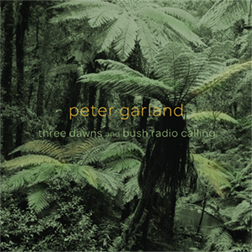
Two exuberant, beautiful solo piano pieces—the three-movement Three Dawns (1981–82), based on poems by Jean-Joseph Rabéarivelo, and the 10-movement Bush Radio Calling (1992), written for the music-theater work Just Them Walking, by New Zealand’s avant-garde theater company Red Mole.
Both works are elegantly and spiritedly performed by Ron Squibbs, a pianist who has also recorded music by Dane Rudhyar and Joji Yuasa.
Peter Garland is a composer, world traveler, musicologist, writer, and former publisher whose music is always informed by his well-traveled ear and strong sense of personal vision. He is a long-time associate of Cold Blue—his music has appeared on seven of the label’s previous CDs.
“Garland’s music seems to be about the sheer expressive power of sound itself…. I feel he is one of our true originals.” —Robert Carl, Fanfare magazine
“Radical consonance’ has been used to describe Garland’s music…an apt choice of words.” —Raymond Tuttle, Fanfare magazine
“[Garland] is an avatar of an experimental American tradition … a composer of mesmerizing music; and in many ways, the musical conscience of my generation.” —Kyle Gann, Chamber Music magazine
John Luther Adams
Lines Made by Walking
and
untouched
CB0058
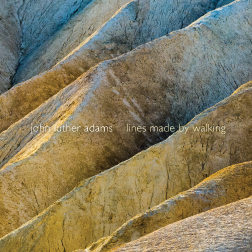
The composer writes: “I’ve always been a walker. For much of my life I walked the mountains and tundra of Alaska. More recently it’s been the Mexican desert, the altiplano, quebradas, and mountain ridges of Chile, and the hills and canyons of Montana. Making my way across these landscapes . . . I began to imagine music coming directly out of the contours of the land.
“I began work on my fifth string quartet, Lines Made by Walking (commissioned by Tippet Rise Art Center, 2019) by composing three expansive harmonic fields made up of tempo canons with five, six, and seven independent layers. Once I’d composed these fields, I traced pathways across them. As I did this, each instrument of the quartet acquired a unique profile, transforming the strict imitative counterpoint of the tempo canons into intricately varied textures.”
The composer writes about untouched: “I stood on the tundra, holding a small Aeolian harp on top of my head, dancing with the wind, turning like a weathervane. Music seemed to flow out of the sky—across the strings, down through my body, and into the earth. From that beginning, I’ve discovered a broad harmonic and melodic palette derived from superimposing the harmonic series on itself at different intervals.
“I composed my first piece for string quartet, The Wind in High Places (2011), when I was fifty-eight. As I wrote it, I imagined the quartet as a single sixteen-string Aeolian harp, with the music’s rising and falling lines and gusting arpeggios coming entirely from natural harmonics and open strings. My second string quartet, untouched (2016), was a further exploration of this sound world, with the fingers of the musicians still not touching their fingerboards.”
This recording of JACK performing Lines Made by Walking is a 2022 Grammy nominee in the Best Chamber Music/Small Ensemble Performance category.
Performed by the incredible, illustrious JACK Quartet.
Adams is a long-time associate of Cold Blue; his music has appeared on six of the label’s previous CDs.
“Adams’s major works have the appearance of being beyond style; they transcend the squabbles of contemporary classical music.” —Alex Ross, The New Yorker
“Adams’s music . . . simply exists, hanging in mid-air, waiting to be listened to.” —All-Music Guide
“Adams’s music is as hypnotic as it is different.” —MusicWeb Int’l
“Adams’s powerful music finds inspiration, depth of field, and sonic substance in the shapes and textures of the natural world and, most of all, in the composer’s own deep and passionate commitment to the act of listening itself.” —Dusted magazine
“One of the most original musical thinkers of the new century.” — Alex Ross, The New Yorker
“Adams’ manner is that of Thoreau—to be in a place, incorporate it into his memory and values, and recreate that through music. It misses the point to say he is inspired by nature—Adams is changed by nature and his music is a catalogue of the places that changed him. . . . Lines Made by Walking is his most intimate music-making to date. . . . [P]oignant and powerful music that shouts into the canyon and wonders if an echo, or something, will return. Beyond its sheer beauty, doing just that makes Adams an important and necessary musician for our time.” —New York Classical Review
“JACK . . . the nation’s most important quartet.” —David Allen, The New York Times
Matt Sargent
Separation Songs
CB0055

Separation Songs is a haunting hour-long continuous work for two string quartets. In it, composer-performer-music technologist Matt Sargent systemically juxtaposes and weaves together an array of 18th-century composer William Billings’s hymn tunes, subtly altering certain aspects of them via real-time-generated variations as the piece unfolds. “Ever wonder what two centuries colliding sounds like…? Listen to Separations Songs.” (Robert Carl)
The composer writes, “Throughout the piece, hymn tunes come and go, passing from one quartet to the other. As tunes reappear, they filter through a ‘separation process,’ whereby selected notes migrate from one quartet to the other. This process leaves breaks in the music that either remain silent or are filled in by stretching the durations of nearby notes, generating new rhythms and harmonies.”
Matt Sargent’s music has been described by critics as “a powerfully organic experience” (Sequenza21) that is “so simple, so natural, and yet sets up a complex set of interactions” (SoundExpanse) as it “uses bare resources to establish a bounded and essential space” (The Wire).
Both quartet parts are performed on this recording by the Eclipse Quartet, a celebrated long-time stalwart of Los Angeles’s new music scene. “The Eclipse [Quartet] is LA’s answer to 20th-century and present-day music.” (HuffPost)
Robert Carl
Splectra
CB0056
Specially priced CD single

Splectra is an elegant harp solo embellished by subtle digital processing. Each of the work’s two sections gradually expands a simple rising motive, becoming harmonically richer by adding pitches related to its opening note’s (low C) harmonic series. Splectra is performed by Los Angeles harpist and new-music champion Alison Bjorkedal. The design and realization of the processing was a collaboration between Robert Carl and Matt Sargent.
Robert Carl is a prolific composer, a performer, and an author of books and articles on new music. His eclectic though often serene compositions usually explore a harmonic language based in the overtone series. “[Carl’s] writing is free of the predictable trappings and dogma, conveying an intelligence that doesn’t need to bury itself in theory in order to express something serious and compelling.” (Time Out New York) “Robert Carl would seem to have a hard time writing dull music.” (Boston Globe) “[Carl] has settled into a more serene, meditative idiom, but still with a dissonant edge.” (Kyle Gann) “[Carl’s] work possesses a great deal of immediate, surface appeal, and yet every piece has deeper layers that repay further listening and consideration.” (Fanfare)
Michael Byron
Bridges of Pearl and Dust
CB0057
Specially priced CD single
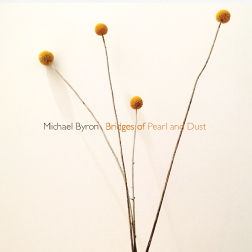
Bridges of Pearl and Dust is virtuosic music for four vibraphones. Polyrhythmic and contrapuntal throughout, it rings out with both inevitably and surprise as it moves through its series of lush, beautiful harmonic fields. It’s a composition wherein continuous activity comfortably shares space with a sense of motionlessness. Via overdubs, all of Bridges‘s four parts are performed for this recording by Los Angeles-based percussionist, composer, and new-music advocate Ben Phelps.
Byron writes, “Bridges of Pearl and Dust is a music about one thing: It points toward a musical experience in the present tense; the burden of anticipation is lifted, and drama, along with its potential for surprise, is abandoned.”
Michael Byron’s music, which tends to be harmonically rich, rhythmically detailed, and virtuosic, is often praised for its ability to create uniquely dense constructions out of relatively limited means: “Byron creates maximalist effect out of minimalist means.” (ClassicalNet) “One is reminded…of the mobiles of Alexander Calder, which are both fixed and moving. And, like Calder’s work, Byron’s music is immediately comprehensible and beautiful, while it remains experimental.” (San Francisco Bay Guardian) “Byron’s music, like Ligeti’s, is instantly recognizable, perceptually challenging, beautifully proportioned and deeply satisfying.” (Paris Transatlantic) “Byron’s music dances with tremulous iridescence.” (Julian Cowley, The Wire)
Michael Byron
Fabric for String Noise
CB0054
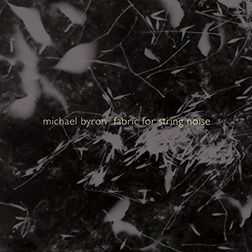
Fabric for String Noise is wildly virtuosic music for two violins. Unlike pretty much anything else written for violins, this new two-movement piece may be said to resemble some sort of universal folk music of madly driven ecstasy, a sonic canvas wherein intense hyperactivity shares space with an overarching sense of motionlessness. Also on the CD is the first recording of an earlier Byron work, Dragon Rite—a slow, beautifully rumbling work for four double basses, occasionally employing quarter-tones.
Fabric is performed by the new-music violin duo String Noise—violinists Conrad Harris and Pauline Kim. Dragon Rite is performed by bassist Jim Bergman.
Michael Byron’s music tends to be harmonically rich, rhythmically detailed, and virtuosic. It is often praised for its ability to create uniquely dense constructions out of relatively limited means: “Byron creates maximalist effect out of minimalist means.” (ClassicalNet) “One is reminded…of the mobiles of Alexander Calder, which are both fixed and moving. And, like Calder’s work, Byron’s music is immediately comprehensible and beautiful, while it remains experimental.” (San Francisco Bay Guardian) “Byron’s music, like Ligeti’s, is instantly recognizable, perceptually challenging, beautifully proportioned and deeply satisfying.” (Paris Transatlantic) “Byron’s music dances with tremulous iridescence.” (Julian Cowley, The Wire)
Michael Jon Fink
Celesta
CB0053

Celesta is a collection of Fink’s alluring, elegant new celesta solos (all previously unrecorded pieces), performed by the composer. This set of pieces, taken as a whole, as a suite, is perhaps the largest statement for the celesta as a solo instrument. (Beautifully recorded on one of LA’s finest five-octave Schiedmayer celestas.)
Fink’s characteristically reductive but expressive music has been described by the Los Angeles Times as “lustrous,” “metaphysically tinged,” and “unapologetically tranquil.” LA Weekly has written that his music is “of ethereal simplicity . . . he has shaped and refined his spare style greatly—it is distinctly his own.”
“There’s something of Gavin Bryars’ evanescent emotional skill to Fink’s music, something of the soft spatial blur of the Evanses (Bill and Gil) … what gets me every time is its sheer and honest beauty.”—Misfit City (UK)
John Luther Adams
Everything That Rises
CB0051
JACK Quartet is Musical America’s “Ensemble of the Year,” 2019
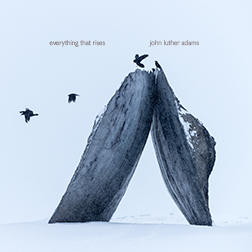
Everything That Rises is an elegant, haunting, and devilishly difficult string quartet. The composer writes: “Everything That Rises, my fourth quartet, grew out of Sila: The Breath of the World—a concert-length choral/orchestral work composed on a rising series of sixteen harmonic clouds. This music traverses that same territory, but in a much more melodic way. Each musician is a soloist, playing throughout. Time floats and the lines spin out, always rising, in acoustically perfect intervals that grow progressively smaller as they spiral upward…until the music dissolves into the soft noise of the bows, sighing.”
Performed by the incredible, illustrious JACK Quartet.
John Luther Adams, a Pulitzer Prize and a Grammy Award winning composer, is a long-time associate of Cold Blue; his music has appeared on six of the label’s previous CDs.
“Everything That Rises is art without artifice, and its beauty transports the listener into a timeless place outside of everyday experience, surely one of music’s most exalted goals.” —New York Classical Review
“Everything That Rises finds Mr. Adams exploring dissonance and just-intonation tuning, in the gentlest of ways.” —New York Times
“Nature and spirit inform every magical page of Adams’ music…. Everything That Rises takes us to a very still place within. Mere words cannot describe it, but music can conjure it. Something tells me John Luther Adams’ ‘sounds in the air’ may well be an answer to a famous koan.” —Bay Area Reporter
“Adams’s major works have the appearance of being beyond style; they transcend the squabbles of contemporary classical music.” —Alex Ross, The New Yorker
“Adams’s music sounds like it has nothing to accomplish. It simply exists, hanging in mid-air, waiting to be listened to.” —All-Music Guide
“Adams’s music is as hypnotic as it is different.” —MusicWeb Int’l
“Adams’s powerful music finds inspiration, depth of field, and sonic substance in the shapes and textures of the natural world and, most of all, in the composer’s own deep and passionate commitment to the act of listening itself.” —Dusted magazine
“One of the most original musical thinkers of the new century.” — Alex Ross, The New Yorker
Peter Garland
Moon Viewing Music (Inscrutable Stillness Studies #1)
CB0052
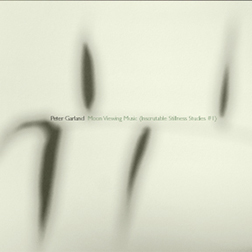
Moon Viewing Music is a quiet, sparse, introspective six-movement work for three large Thai-style gongs and large tam-tam, performed by the celebrated new-music percussionist William Winant.
Composer Peter Garland is a long-time associate of Cold Blue; his music has appeared on six of the label’s previous CDs.
“Garland’s music seems to be about the sheer expressive power of sound itself…. I feel he is one of our true originals.” —Robert Carl, Fanfare magazine
“‘Radical consonance’ has been used to describe Garland’s music…an apt choice of words.” —Raymond Tuttle, Fanfare
“[Garland] is an avatar of an experimental American tradition … a composer of mesmerizing music; and in many ways, the musical conscience of my generation…. Garland’s work always brings increasing cognitive involvement; it is much more intricate than it sounds at first.” —Kyle Gann, Chamber Music magazine
“Ever his own man, Garland has moved beyond a strictly minimalist phase of evolving melodic and rhythmic patterns into a hybrid sphere of many influences from the panorama of world music, suggestive of such composers as Conlon Nancarrow and Lou Harrison.”—San Francisco Chronicle
“Garland’s…compositions exist entirely on their own terms.” —Signal to Noise magazine
“Garland’s not a very baaaad-assed composer, but he’s one of the best.”—Kyle Gann, Village Voice